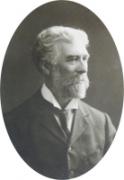|
|
||||||||||||||||||||||||
 |
Featured person
Recently added |
Robert Coffey (1796 - 1847): |
||||||||||||||||||||||
Robert Coffey was born in County Antrim in 1796. Little is known of his background or early life, but he attended medical classes in Edinburgh and/or Glasgow, took the Licence of the Royal College of Surgeons of Edinburgh (LRCS, Edinb.) in 1819 and that of Apothecaries Hall, Dublin in 1820. On 22 May 1820 he married into the Belfast Blackwood family and soon was in practice as an apothecary at 49, Ann Street. He was active professionally being an early member of the revived Belfast Medical Society in 1822 and in the same year was appointed a “medical attendant” to various (of the six) dispensary districts in Belfast, and in 1827 “attending surgeon” to the Fever Hospital and progressing (1836-1847) “consulting surgeon”, and in 1823 was appointed to the Fever Hospital Management Committee later being its chairman. He became MD of the University of Glasgow in 1833, took an increasing interest in the teaching and welfare of his students and was one of the 37 colleagues who subscribed in 1834 to an inscribed gold snuff box to Dr. SS Thomson (Malcolm’s “father of the profession in Belfast”), and in 1832 when the Royal Belfast Academical Institution (RBAI) encouraged its prospective medical staff applicants to give ad hoc classes, Coffey gave them in surgery for the session 1834-5. However, when the chair of surgery was established (from the 1835-6 session) Coffey lost out to John MacDonnell, son of the influential James MacDonnell, and who was the Moderator of the General Synod’s preferred choice, by 13 votes to 7. (At the time at RBAI, the Moderator of the General Synod of the Presbyterian Church could scrutinize applications and make the Synod’s preference known to the Joint Boards of Managers and Visitors - effectively the Governors of the Institution - before any decision was made!).
MacDonnell, however, resigned after three months in office (on 19 January 1836) to be a consultant surgeon at the Richmond Surgical Hospital and the House of Industry in Dublin. His successor was Thomas Ferrar who was narrowly preferred to Coffey (by 10 votes to 9) but only after two postponements of the interviews because of unsympathetic anonymous letters “from a warm friend of Inst [RBAI]”, the opposition to Coffey of the Moderator, and one member of the 20-man appointing body absenting himself. Ferrar failed to turn up for the start of the session and was dismissed on 22 November 1836. Coffey, now the only candidate, was elected unanimously on 19 January 1837 despite continued opposition from the General Synod (Coffey was ‘new light’, that is, a Non-Subscribing Presbyterian whereas the General Synod was ‘main-stream’; the two were bitterly opposed, and not only on doctrine!). The choice of Coffey was popular and on 26 April 1839 the students presented him with an illuminated Address (now in the possession of the present author).
Coffey, now living at 59 Donegall Street remained active in the Faculty’s and students’ interests as well as that of the patients. He attended faculty meetings regularly, was its ‘President’ (i.e. Dean) in 1839-40, and in March 1841 argued vigorously for having the College Hospital re-opened and adequately financed, and to include non-infectious disease victims as in-patients not only for their own good but for student clinical instruction since, as he said, “there is much reason to believe that several of last year’s pupils have declined returning this session owing to the want…of teaching beds”. It was unavailing. The enterprise of a college-controlled teaching hospital was for various reasons dead; the opening of the Belfast Union (workhouse) Infirmary, which was also in 1841, and the plans for the Queen’s College in Belfast which were maturing, would bury it, and these may have prompted Coffey’s pleading. The College Hospital building was in subsequent years used for other purposes through lettings and ultimately sale. Coffey now virtually disappears from the available records but was still in post when he died on 5 January 1847 at Botanic Road, Belfast, and is buried in Clifton Street Graveyard in the city. His son, Charles, of the Naval Medical Service, died in the Far East on 20 October 1851 when assistant surgeon on HMS Pilot.
| Born: | 1796 |
| Died: | 5 January 1847 |
| Peter Froggatt |
| Bibliography: Froggatt, P: ‘The foundation of the “Inst” medical department and its association with the Belfast Fever Hospital’, (Ulster Medical Journal, 45, 107-145, 1976); ibid, ‘Thomas Ferrar, MB, LRCSI (1797-1837): the absentee professor of surgery at the Royal Belfast Academical; Institution (Ulster Medical Journal, 65, 153-161, 1996); ibid., ‘The first medical school in Belfast, 1835-1849’ (Medical History, 22, 237-266, 1978); Calwell, HG, Andrew Malcolm of Belfast, 1818-1856: Physician and Historian. (Belfast: Brough, Cox & Dunn, 1977); Malcolm, AG, History of the General Hospital, Belfast and the other Medical Institutions of the Town, etc. (Belfast: W & G Agnew, 1851); Clarke, RSJ, A Directory of Ulster Doctors (Belfast, Ulster Historical Foundation, 2013, vol. I, p.197) |


Home | Our Policies | Plaques | Browse | Search | Sponsors | Links | Help | Contact
Privacy & Disclaimer | Cookie Policy | Site Map | Website Design By K-Point
© 2024 Ulster History Circle









